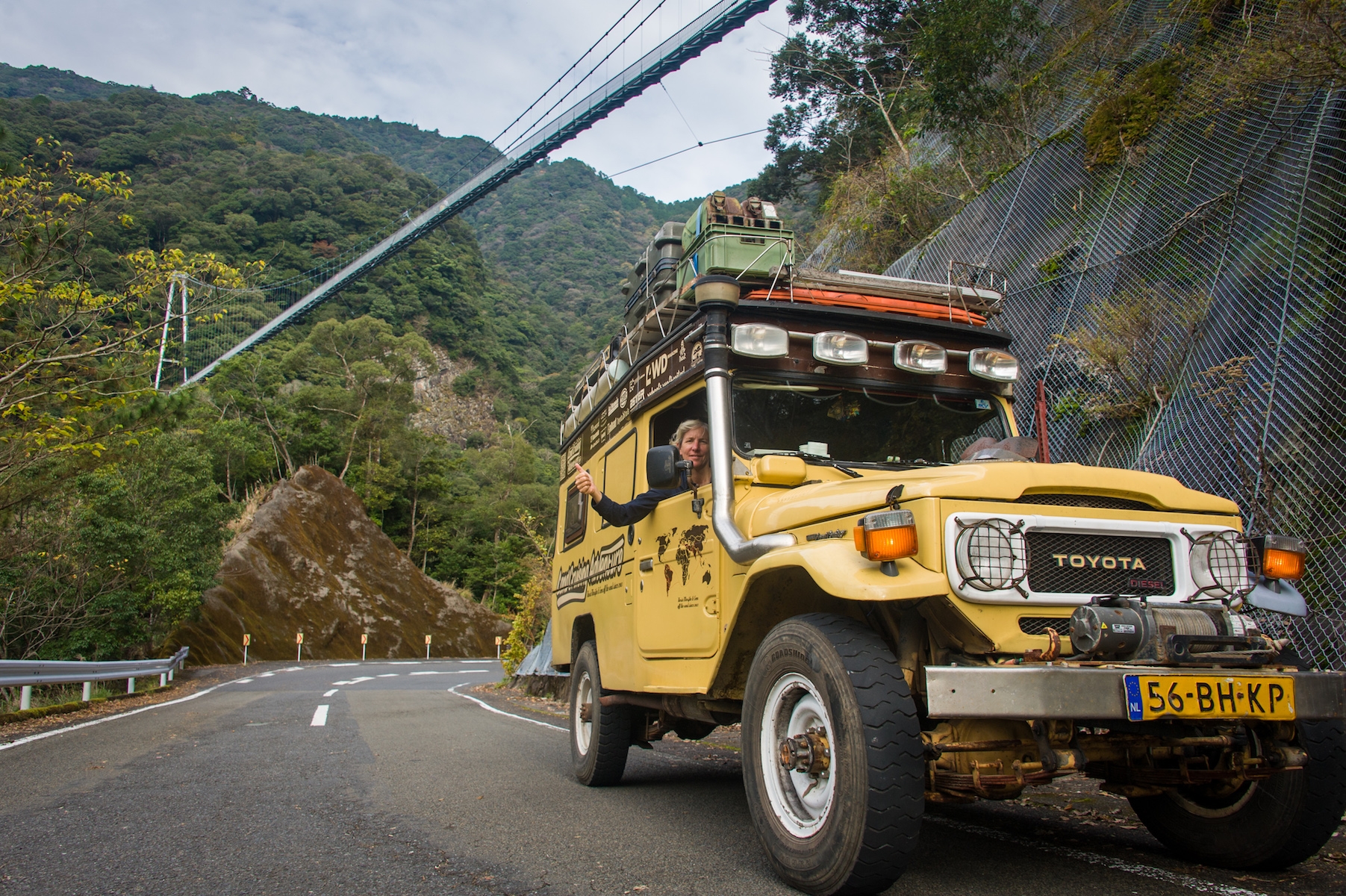Let’s take a closer look.
On the Road
The mountainous island of Kyushu is covered with beautiful cedar pines. The ancient ones, with massive, awe-inspiring trunks that reach for the sky grow around Shinto temples, along the staircase leading up to the main hall or in the grounds around them. Along the road sitjizos–small, often childlike, statues in meditation position. They are guardian deities and with winter on its way, people give them hats andscarves to protect them against the cold.
Narrow, asphalted roads twist and turn back on themselves, leading from forests to valleys allocated for agriculture and dotted with hamlets. Parabolic mirrors in every curve facilitate the driving and makes honkingyour horn to warn oncoming traffic unnecessary. Even though we were in Toyota country, our truck was as conspicuous as ever. The 1984, tall and bright yellow Land Cruiser BJ45 stood out in the crowd of small, flashy Japanese cars that characterize the roads. Many Japanese didn’t realize we were drivingan actualToyota. Even when we pointed out the logo, some responded with an unconvinced look, “Really? This is Toyota?!” The Japanese people don’t typically own oldercars, plustaxes are higher on older vehicles.
Volcanic Activities
Inland lies the Mount Aso caldera, with eighty miles in circumference the it’s the world’s largest volcanic crater. The Aso Volcano is Japan’s highest volcano (5220 feet) and was active when we were there, making it impossibleto walk up the edge and peek down. We had to make do with the Volcano Museum onsite for more information and detailed pictures. But the trip wasn’t a waste of time. The surrounding landscape characterized by high grasslands is magnificent for driving and hiking.
In Minamiaso (lit: 'South of Aso') we learned how to cook soba noodles (buckwheat noodles) in the Soba Dōjō restaurant(Dōjōmeans “place for learning”). Mrs Furusho was patient but very specific in her instructions: don’t push too hard, roll out the dough deeper and thinner, and mix with more kindness and dedication. She almost made us talk to the dough, I felt. We handed over the process of preparation to the cooks who lowered the noodles into boiling water and a few minutes later they were served on a tray with soya sauce and side dishes. I’m sure we won’t get a Michelin Star any time soon for our noodles,but it was quite satisfying to eat a tasty meal that was of our own making.
On the east coast lies Beppu, arguably Kyushu’s biggest attraction. Set up by the founder of the Jishusect of Buddhism it was once a health spa in the middle of nowhere. Today it has a high level of ‘Disneyworld’ entertainment, as Coen and I like to call such a place. Despite the hordes, it was worth a visit. Beppu boasts the second highest number of hot springs in the world and the city abounds with hot baths ranging from small, basic ones to the most extravagant spas. En masse people visit the surrounding jigokus(‘hell’), hot pools in the boldest of colors, from bubbling grey mud to boiling, blood-red clay with red steam rising from the surface, and turquoise water smooth as glass. We ate eggs and corn on the cob prepared with steam from the Kamado Jigoku (‘furnace’ or ‘oven hell’) while we soaked our feet in scalding hot, transparent water. All of this,of course, is very good for your health.
A Lesson in History in a Samurai Town
Driving a bit farther south we were in for some Dutch history and being from the Netherlands, we were intrigued. In 1600, while searching for Japan, the Dutch had got lost and sailors were dying. The ship ‘De Liefde’ stranded and the 23 survivors were saved. This unexpected encounter became the start of a trade relationship between the two countries that lasted several centuries, while all other countries were banned from coming here. Together with the Chinese, the Dutch were required to live secluded on the island of Dejima, which is now part of Nagasaki (on the west coast). Only goods could go to the other shores, no foreigners. This fact aside, Usuki was our introduction to Japan’s picturesque samurai towns that you find throughout Kyushu as well as Honshu. On the hilltop were the remains of a castle, which in Japan looks more like a vast white mansion than like the gray fortress-type constructions we have in Europe.
Usuki itself is a tranquil, pleasant town. Strolling the narrowNiōza-Historical Roadwe admired the rustic architecture of white plastered or natural stone walls and the traditional, unpainted wooden houses. At the far end we crossed the road and visited the impressive Ryugen-ji temple. It had an elaborate three-story pagoda and, adjacent, an old cemetery with a higgledy-piggledy collection of weathered stones covered with moss and lichen. In between we stumbled upon little Buddha statues and couldn’t miss the occasional modern tomb of smooth, shiny natural stone, which looked out of place.
Back in the countryside we stopped at a suspension bridge that hangs across the stunning Ayakawa Gorge. Being 820-footin lengthand 465-foot in height,it is one of the highest pedestrian suspension bridges in the world. From the bridge we looked out over the evergreen primeval forests that cover the slopes. Beyond the bridge a trail zigzagged through the forest for about a mile and we were warned to watch our step because ofpoisonous snakes that might be warming up in the sunrays that shone across the path.
Beaches and Hippy Vibes
We headed to the beaches of Miyamija, in the southeastern corner of Kyushu. Here you may meet people who refuse to buy food from Honshu,afraid of the Fukushima pollution and not trusting the government to be honest about it. Many grow their own food, including rice. Along the roads (throughout the country) are machines where people can take their harvested rice and have it dehusked. People from Honshu come here to settle in the countryside, sometimes maintaining a somewhat hippie lifestyle and maybe joining the surfing scene that is particularly alive along Miyazaki’s coast in the southeastern corner. Some start their own business, whether a car workshop, a restaurant, or something else. Most of the people we met were fed up with the world of consumerism, didn’t care about wealth and belongings, and just wanted to live happy, peaceful and easy going lives.
On Miyamija's beaches we unfolded our rooftop tent and took swims in the lukewarm waters. It was the perfect region to unhurry, to absorb and digest all the information and sights of the past few weeks. It was time for a rest. We had explored only the east side of the island. The south and west were patiently waiting until we we're ready for them. We would need many more weeks to see it all, but that will be another story.
Freelance writer Karin-Marijke Vis, along with her partner Coen Wubbels, photographer, combine their love for adventure withwork they enjoy. Sometimes described as being the ‘slowest overlanders in the world,’ they believe in making connections and staying in a place long enough to do so. In 2003 the couple purchased an antique BJ45 Land Cruiser and after a 3-year trip from their home in the Netherlands to Asia they traveled in South America (9 years) and the Far East (2 years). Karin-Marijke and Coen are currently traveling in Russia. They’ve been published in car/4x4 and travel magazines around the world. How to follow their adventures:
Website: https://landcruisingadventure.com
Facebook: http://facebook.com/landcruising
Instagram: https://www.instagram.com/landcruising.adventure
[flickr set=72157703796177634]
To get your copy of the
Summer 2018 Issue:
Follow us on Facebook, Twitter, and Instagram to get up-to-date industry news, events, and of course, amazing adventures, stories, and photos!













